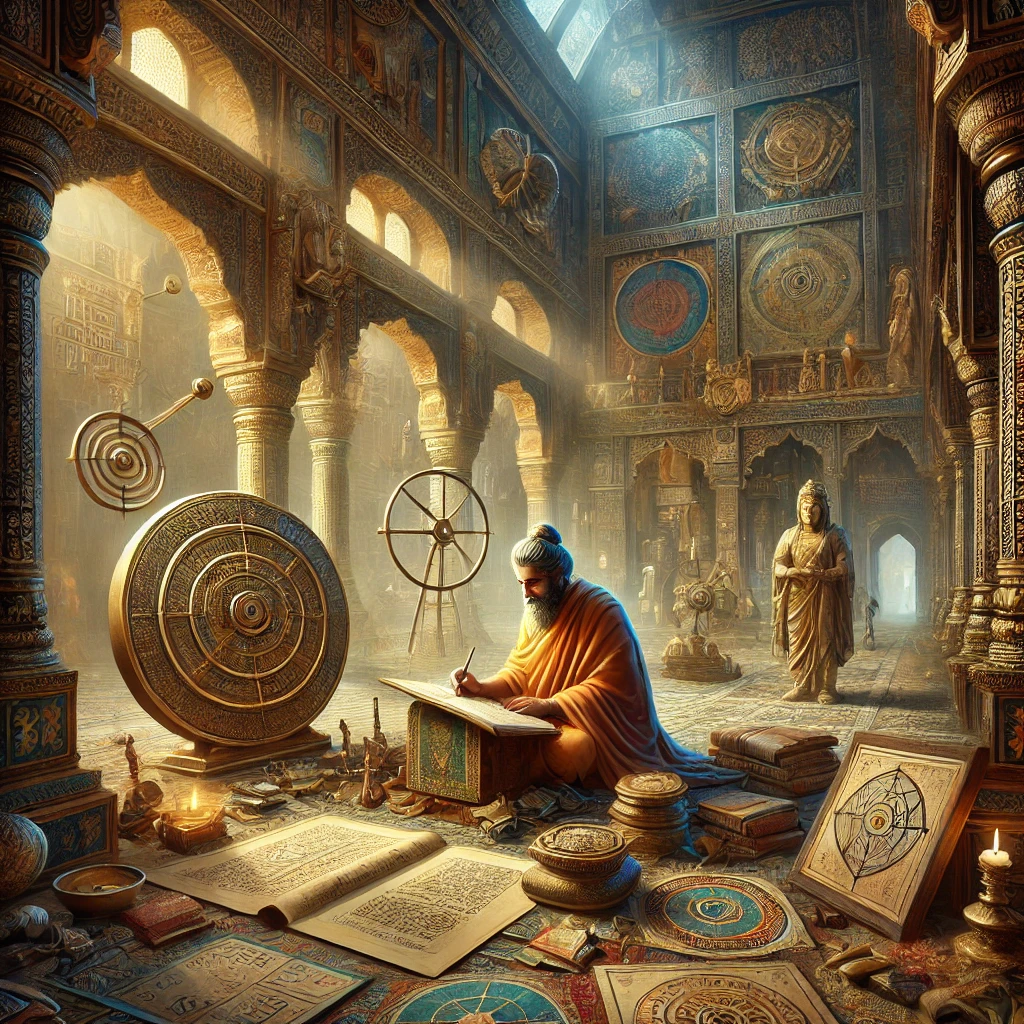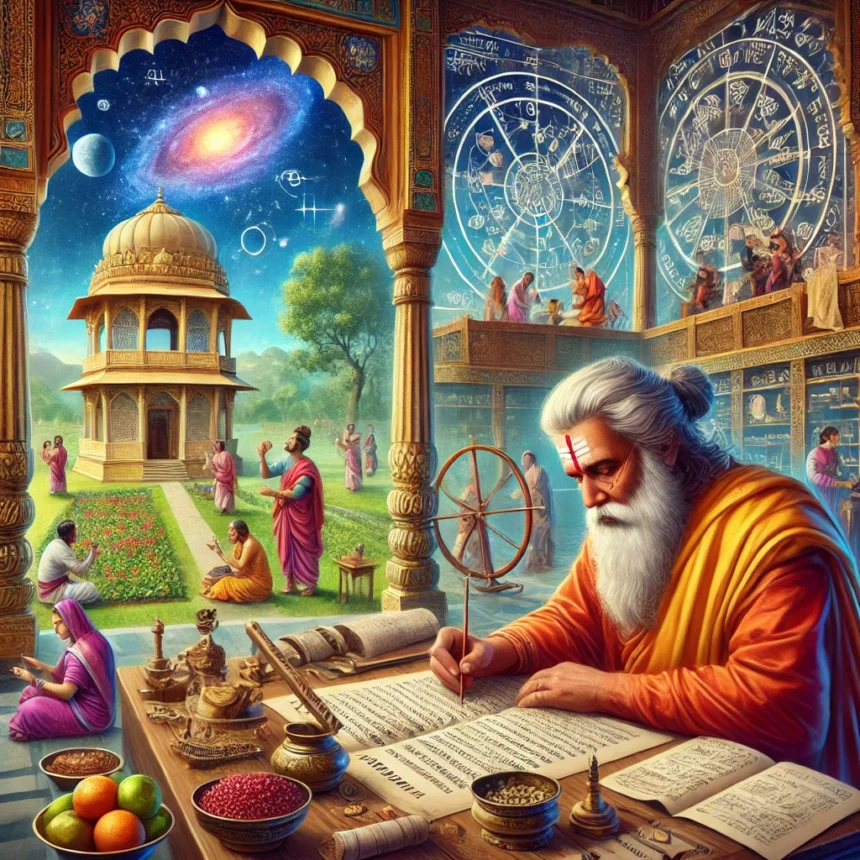Kautilya: The Timeless Sage of Statecraft and Strategy-I
Introduction
In the annals of history, few have left as indelible a mark on the art of governance and the science of statecraft as Kautilya, also known as Chanakya. His seminal work, the Arthashastra, not only sculpted the political landscape of ancient India but also offered a blueprint for leadership and administration that remains relevant today. This treatise, crafted in the turbulent era of the 4th century BCE, during the rise of the Maurya Empire, is a profound testament to the advanced thinking and strategic acumen of its time.
Born in a period characterized by significant intellectual and cultural ferment, Kautilya was a contemporary of other great thinkers across the world, each shaping their own philosophical and political landscapes. His insights into governance, which were deeply influenced by the rich tapestry of Hindu culture known for its extensive contributions to various fields such as science, agriculture, art, and philosophy, highlight a pragmatic approach that effectively combines ethical mandates with political necessity. This blog delves into Kautilya’s life, his works, and his enduring influence, comparing his methodologies with those of his contemporaries globally to underscore the timeless relevance of his teachings in modern governance and strategy.
Background: The Rich Tapestry of Hindu Culture
Diving into the backdrop of Kautilya’s life, we find ourselves in the rich cultural milieu of ancient India, a civilization renowned for its intellectual depth and philosophical prowess. Let us explore how the vibrant Hindu culture of that era, with its comprehensive knowledge in various fields, provided a fertile ground for the emergence of great thinkers like Kautilya.
Ancient Hindu culture is celebrated for its profound contributions to a variety of disciplines including science, agriculture, art, architecture, and philosophy. This culture, rooted deeply in the fertile soil of the Indian subcontinent, has shown a remarkable continuity that stretches back thousands of years, seamlessly integrating ancient wisdom into the present.
The era of this culture is marked by its longevity, having sustained through various historical and political transformations while continuously evolving. This enduring nature is not merely a testament to the resilience of its traditions but also highlights a dynamic adaptability that absorbed and assimilated diverse influences over millennia.
This vibrant cultural period was incredibly fertile ground for the emergence of numerous eminent thinkers who made significant contributions across various fields. The intellectual richness of this era can be traced back to the extensive array of Vedic texts such as the Vedas, Upanishads, and later philosophical treatises like the Puranas and the epic narratives of the Mahabharata and Ramayana. These texts not only served as the spiritual and philosophical bedrock of Hindu culture but also as a springboard for intellectual inquiry and exploration.
Moreover, the cultural practices, rituals, and teachings derived from these texts created an environment ripe for intellectual development. The guru-shishya (teacher-disciple) tradition facilitated a personalized transmission of knowledge, ensuring that these complex ideas were not only preserved but also continuously interpreted and expanded upon. The holistic approach of this tradition, which integrated ethical living with intellectual pursuit, cultivated a unique scholarly community that was as devoted to the practical applications of their knowledge—be it in agriculture, metallurgy, or medicine—as they were to its philosophical underpinnings.
Thus, the ancient Hindu culture, with its rich tapestry of thought and tradition, a repository of knowledge that also was a catalyst for profound intellectual and spiritual growth. This environment nurtured the minds of great thinkers like Kautilya, who in turn shaped the political and economic landscapes of their times through their revolutionary ideas.
Kautilya: The Greatest Thinker

Against the vibrant backdrop of ancient India’s golden age, Kautilya emerged as a pivotal figure. Let us now delve into his life during the 4th century BCE, a time of significant political upheaval and intellectual vigor, setting the stage for his revolutionary ideas that would script the course of Indian governance.
Kautilya, also known as Chanakya, was an ancient Indian scholar and statesman who lived during the 4th century BCE. Often regarded as a pioneer in the study of political science and economics, Kautilya served as the chief advisor to Chandragupta Maurya, the founder of the Maurya Empire. His life and work occurred during a time of significant political upheaval, where the subcontinent saw the consolidation of various small kingdoms into larger states and empires.
Kautilya’s magnum opus, the Arthashastra, is not just a treatise but a comprehensive guide covering all aspects of governance. Written in Sanskrit, this seminal work delves deep into statecraft, economic policy, and military strategy. It meticulously outlines the art of governing a kingdom, addressing everything from financial management and civil administration to foreign policy and warfare. The Arthashastra is celebrated for its analytical approach and detailed attention to the mechanics of governance and public administration. Kautilya’s insightful contributions to political theory, particularly his nuanced understanding of power dynamics and the critical importance of a ruler’s duty towards effective governance and economic welfare, have been profoundly influential in shaping the field of political science.
Other Prominent Thinkers of India
While Kautilya’s insights into statecraft and economics were groundbreaking, he was not alone in shaping Indian intellectual traditions. Let us now introduce other luminaries of the period, whose contributions spanned from philosophy and science to the arts, forming a constellation of brilliance that illuminated various facets of life and thought.
Throughout Indian history, numerous thinkers have made significant contributions to various fields of knowledge. From the same classical period as Kautilya, we encounter Patanjali, who systematized the practice of yoga through his influential work Yoga Sutras. Patanjali’s philosophy, unlike Kautilya’s focus on the material and political welfare of the state, centers on the spiritual development of the individual, offering a methodical approach to achieving spiritual liberation.
In a slightly later era, the sage Vatsyayana authored the Kamasutra, a text on love and emotional fulfillment that is often misunderstood as merely an erotic manual. While both Kautilya and Vatsyayana addressed aspects of human desire, Kautilya’s treatment in the Arthashastra is from the perspective of managing a kingdom’s resources and people to fulfill these desires in a way that strengthens the state.
Additionally, during this vibrant period of intellectual exploration, we also see advancements in other scientific and scholarly fields. The author of Ashtadhyayi, Panini, developed one of the earliest known grammars of Sanskrit, influencing subsequent linguistic theory. Similarly, Sushruta, often called the master of surgery, authored the Sushruta Samhita, which detailed complex surgical techniques for the first time in human history, illustrating a profound knowledge of anatomy and medicinal treatments.
Moving to the medieval period, Adi Shankaracharya, a philosopher and theologian, rejuvenated the Advaita Vedanta school of Indian philosophy. His teachings, emphasizing non-duality, stand in stark contrast to Kautilya’s realpolitik and pragmatic administration. Shankaracharya’s works delve into the metaphysical questions of existence and the universe, offering spiritual insights intended to transcend the physical and political concerns of earthly life.
Key Schools of Indian Philosophical Thought
Other thinkers who existed during various periods include
- Bhartrihari (5th century CE): Work on grammar and philosophy, particularly the Vakyapadiya.
- Charaka (2nd century BCE): The principal contributors to Ayurveda, who authored the Charaka Samhita.
- Abhinavagupta (10th-11th century CE: Significantly contributed to Shaivism and the Indian theory of aesthetics with his synthesis and analysis of Tantra, Yoga, and the Pratyabhijna (recognition) philosophy.
- Kalidasa (4th-5th century CE): Considered the greatest playwright and poet in the Sanskrit language, with works like Shakuntala and Meghaduta.
- Nagarjuna (c. 2nd century CE): The founder of the Madhyamaka school of Mahayana Buddhism, who introduced the concept of Shunyata (emptiness).
In addition there are other philosophies that richly contribute to the richness of Indian philosophy
- Nyaya: The school of logic, founded by Sage Gautam. Nyaya philosophy is based on reason and experience, and uses a scientific approach.
- Vaisheshika: The school of atomic theory, founded by Sage Kanad.
- Sankhya: The school of analysis of matter and spirit, founded by Bhagwan Kapil.
- Poorva Mimamsa: Founded by Sage Jaimini.
- Uttar Mimamsa (Brahm Sutra): Founded by Bhagwan Ved Vyas.
These thinkers, each from different periods and with diverse focus areas, collectively contribute to the rich intellectual tradition of India. While Kautilya’s works are grounded in the practicalities of governance, thinkers like Patanjali, Panini, Sushruta, and Shankaracharya offer paths towards personal and spiritual fulfillment, illustrating the broad spectrum of human inquiry and existence contemplated by Indian philosophy.
Comparative Analysis with Global Thinkers
Kautilya’s contemporaries were not confined to the Indian subcontinent. Globally, thinkers like Plato, Aristotle, and Confucius were also exploring and redefining concepts of governance, ethics, and society. We now compare these global intellectuals, highlighting the diversity and depth of philosophical thought across different cultures during Kautilya’s time.
Kautilya’s era, the 4th century BCE, was a time of great intellectual activity not just in India but around the world. During this period, several other prominent thinkers were shaping philosophical and political thoughts across different cultures.
- Plato (Greece): Plato, a philosopher in classical Greece, established the Academy in Athens and wrote dialogues that tackled ethics, politics, and metaphysics. Unlike Kautilya, who emphasized practical governance strategies and realpolitik, Plato’s idealism focused on the concept of philosopher-kings governing a state organized by rigid societal classes determined by innate ability and merit. Plato’s Republic envisions a society governed by justice and ruled by philosopher-kings, which contrasts with Kautilya’s more pragmatic and often ruthless methods of maintaining control and administering governance.
- Aristotle (Greece): Aristotle, Plato’s student, delved deeply into ethics, politics, and the ideal forms of government. While Aristotle explored various forms of governance, he preferred a constitutional government run by the middle class, which he saw as stable and moderate. Kautilya, on the other hand, detailed a monarchial system where the king, advised by a council and an elaborate bureaucracy, uses espionage, statecraft, and economic policies to maintain order and expand territory.
- Confucius (China): Roughly contemporary with Kautilya, Confucius formulated a philosophy that emphasized ethics, familial loyalty, and social harmony. While Kautilya’s Arthashastra focused on the machinations of state and power, Confucius’s teachings promoted a societal order based on moral rectitude and hierarchical respect, principles meant to permeate every level of personal and state interactions.
Perspectives on Governance
The 4th century BCE was a fertile era for philosophy, with thinkers like Kautilya, Plato, Aristotle, and Confucius shaping foundational ideas about governance and society.
- Plato vs. Kautilya: Plato’s theory of philosopher-kings and a merit-based societal order contrasts with Kautilya’s practical, power-centered governance strategies.
- Aristotle vs. Kautilya: Aristotle’s advocacy for a balanced governance led by the middle class diverges from Kautilya’s centralized authority focused on control and expansion.
- Confucius vs. Kautilya: Confucius emphasized ethics and social harmony, contrasting with Kautilya’s emphasis on statecraft and realpolitik.
These thinkers offer diverse insights into governance that continue to influence modern discussions on policy-making and leadership, providing valuable perspectives for contemporary governance challenges.
Impact of Kautilya vis-à-vis Other Global Thinkers
Kautilya’s influence extends far beyond the ancient Indian borders, resonating through the ages and across continents. We now explore how his pragmatic approach to governance continues to find relevance in modern administrative and economic strategies, and how it stands in contrast to other philosophical giants of his era.
Influence within India and Globally
Kautilya’s impact on Indian political and economic thought has been profound and enduring. The Arthashastra is considered one of the first and most sophisticated treatises on statecraft and economics, predating Machiavelli’s “The Prince” by nearly two millennia. His realistic approach to governance, emphasizing espionage, welfare, and economic prosperity, has been studied and respected by leaders and scholars throughout Indian history and into the modern era.
Influence on Later Thinkers and Modern Relevance
Globally, Kautilya’s ideas found resonance much later, as his works were only translated into Western languages in the early 20th century. However, his principles of governance, particularly regarding the management of a state’s economy and resources, have parallels in modern public administration and political strategy. His insights into the dynamics of power and governance continue to be relevant today, often compared to those of Machiavelli and Sun Tzu for their ruthlessness and depth of strategic understanding.
Comparative Impact
While Plato and Aristotle have influenced Western thought extensively, shaping the foundations of Western philosophy, politics, and ethics, Kautilya’s Arthashastra has played a similar role in South Asia, offering a realist and pragmatic approach to governance. Confucius’s impact, particularly in East Asia, promotes ethics over pragmatism, emphasizing moral leadership over strategic cunning.
Kautilya’s teachings, celebrated for their directness and practical applicability in both ancient and contemporary governance, underscore a universal truth across all political philosophies: the stability of a state relies significantly on the harmony between its leadership’s strategies and its people’s welfare. Serving as a comprehensive guide, his work remains a critical resource for understanding the intricacies of ancient governance and its implications for modern political and economic strategies, thoroughly covering every aspect of life and governance.
Reflections of Kautilya and his Philosophy
Throughout this exploration, Kautilya’s unique position in the annals of intellectual history as a seminal figure in the development of political science and economics has been clearly established. Known for his astute observations and strategic insights in the Arthashastra, Kautilya’s work transcends the geographical and temporal boundaries of ancient India, offering timeless wisdom on governance and statecraft. His pragmatic approach to ruling, detailed analysis of economics, and nuanced understanding of human nature and societal dynamics highlight his unparalleled intellectual depth.
Drawing from the rich tapestry of Hindu culture, which is renowned for its deep contributions to science, agriculture, art, and more, Kautilya’s work serves as a comprehensive guide, integrating philosophical, political, and economic theories into a coherent framework that addresses the entirety of life and governance. His practical strategies for managing a state’s resources effectively and his methods of leadership continue to influence modern administrative and economic strategies worldwide.
Kautilya’s contributions also resonate with universal themes that are as relevant today as they were in his time. His reflections on governance, ethics, and the responsibilities of a ruler provide crucial insights into the complexities of leadership and the ethical dilemmas faced by those in power. These themes echo in contemporary discussions on political accountability, economic management, and the ethical implications of leadership decisions, proving that his teachings are not only historically significant but also enduringly applicable in today’s globalized world.
Call to Action
The rich tapestry of ideas presented by Kautilya in the Arthashastra is just a glimpse into the vast intellectual heritage of ancient philosophers. I invite you to delve deeper into the life and works of Kautilya and other influential thinkers to uncover the wisdom that has shaped civilizations across centuries.
How do you think Kautilya’s teachings can be applied to modern-day governance and ethical dilemmas? Could his insights enhance contemporary strategies in political and economic spheres? Share your thoughts and engage in this conversation to explore how ancient wisdom can address modern challenges, providing solutions that are as practical today as they were over two millennia ago.
Feature Image: Click here to view the image.
Visit our YouTube Channel by clicking here.
Follow us on our social median handles
Glossary of Terms:
- Arthashastra: An ancient Indian treatise on statecraft, economic policy, and military strategy written by Kautilya.
- Vedas: Ancient Indian scriptures that form the foundation of Hinduism.
- Upanishads: Ancient Indian philosophical texts that explore the nature of reality and the self.
- Puranas: Ancient Indian texts that contain stories, legends, and myths.
- Mahabharata: An ancient Indian epic that tells the story of a great war.
- Ramayana: An ancient Indian epic that tells the story of Prince Rama’s journey.
- Dharma: A Sanskrit term that refers to duty, morality, and righteousness.
- Artha: A Sanskrit term that refers to wealth, prosperity, and economic well-being.
- Kama: A Sanskrit term that refers to desire, pleasure, and sensual enjoyment.
- Moksha: A Sanskrit term that refers to liberation, salvation, and spiritual freedom.
- Kautilya: An ancient Indian scholar, statesman, and philosopher who wrote the Arthashastra.
- Chanakya: Another name for Kautilya.
- Patanjali: An ancient Indian philosopher who systematized the practice of yoga.
- Panini: An ancient Indian grammarian who developed one of the earliest known grammars of Sanskrit.
- Sushruta: An ancient Indian physician who authored the Sushruta Samhita, a treatise on surgery and medicine.
- Adi Shankaracharya: A medieval Indian philosopher and theologian who rejuvenated the Advaita Vedanta school of Indian philosophy.
- Plato: A Greek philosopher who founded the Academy in Athens and wrote dialogues on ethics, politics, and metaphysics.
- Aristotle: A Greek philosopher who studied under Plato and made significant contributions to ethics, politics, and philosophy.
- Confucius: A Chinese philosopher who emphasized ethics, familial loyalty, and social harmony.
- Machiavelli: An Italian philosopher who wrote “The Prince,” a treatise on politics and statecraft.
- Sun Tzu: A Chinese philosopher who wrote “The Art of War,” a treatise on military strategy.
- Guru-shishya tradition: A system of knowledge transmission in ancient India where a teacher (guru) imparted knowledge to a student (shishya).
- Nyaya: A school of Indian philosophy that emphasizes logic and reason.
- Vaisheshika: A school of Indian philosophy that emphasizes atomic theory.
- Sankhya: A school of Indian philosophy that emphasizes the analysis of matter and spirit.
- Poorva Mimamsa: A school of Indian philosophy that emphasizes the interpretation of the Vedas.
- Uttar Mimamsa (Brahm Sutra): A school of Indian philosophy that emphasizes the interpretation of the Upanishads.
Top #Tags: #Kautilya #Arthashastra #Statecraft #PoliticalPhilosophy #AncientWisdom



Leave a Reply